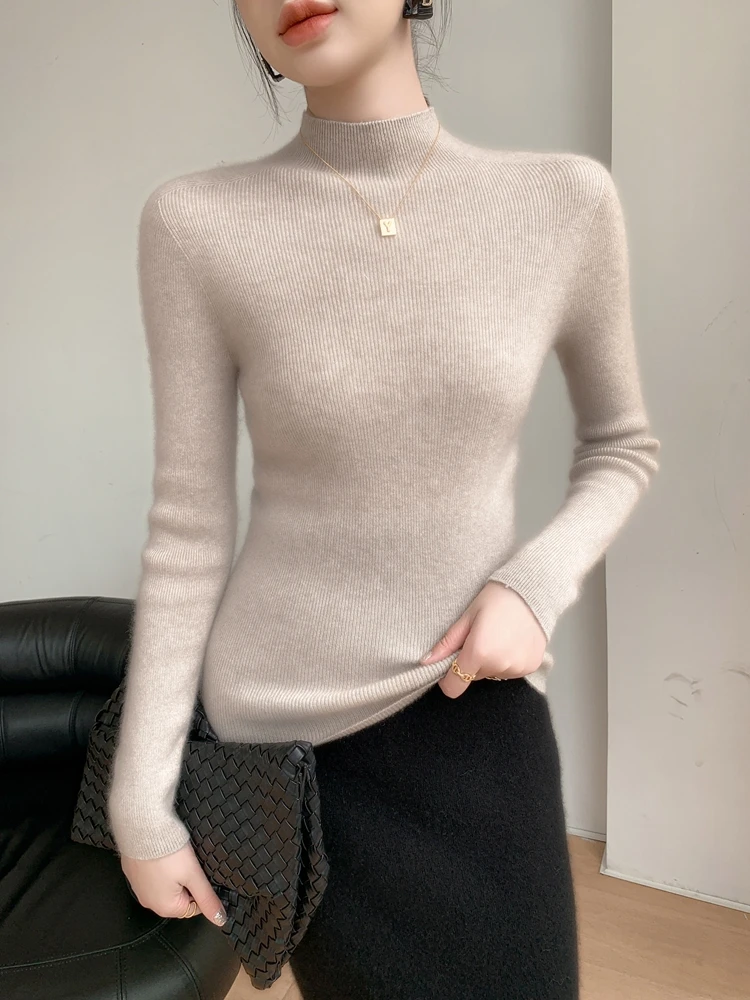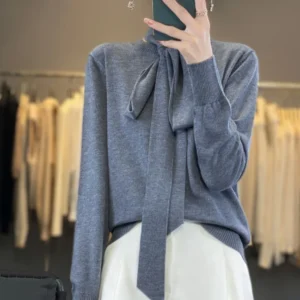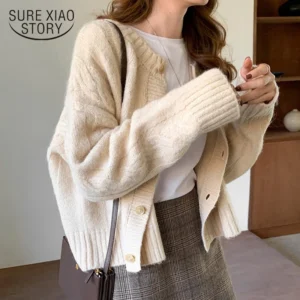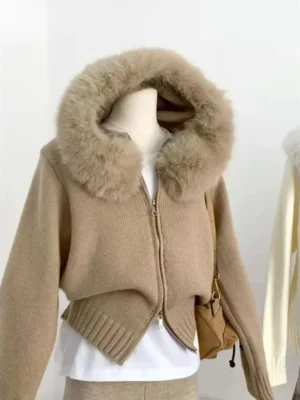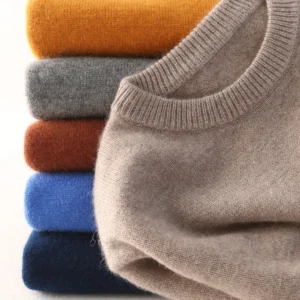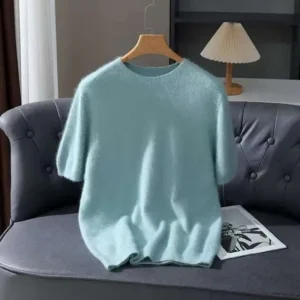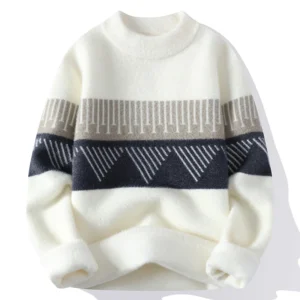Introduction: Cashmere in the Workplace – Luxury Meets Professionalism
Cashmere, with its irresistible softness and luxurious drape, has transcended its origins as purely weekend wear to become a sophisticated staple in professional wardrobes. The challenge many face isn’t whether to incorporate this premium fabric into office attire, but how to balance its inherent luxury with workplace professionalism.
What makes cashmere particularly suitable for office environments is its remarkable functionality. Few fabrics offer the same temperature-regulating properties – cashmere can maintain body temperature within 1.5°F regardless of external conditions, making it ideal for unpredictable office climates. This natural breathability ensures comfort during long meetings or stressful presentations without sacrificing elegance.
The evolution of cashmere in professional settings reflects a broader shift toward quality over quantity in workplace attire. Today’s professionals increasingly recognize that well-selected premium pieces can project competence and attention to detail while providing genuine comfort throughout demanding workdays.
Throughout this guide, you’ll discover how to select appropriate cashmere pieces, apply key styling principles, and create specific professional outfits that elevate your workplace presence. The styling tips for cashmere cardigans you’ll learn can transform these versatile pieces from casual comfort to polished professionalism with just a few strategic choices.
Selecting Office-Appropriate Cashmere: Quality Considerations
When investing in cashmere for professional environments, quality isn’t just about luxury—it directly impacts how the garment performs and appears in workplace settings.
Quality Markers for Professional Cashmere:
- Grade: Grade A cashmere (under 16 microns thickness and over 36mm length) offers the optimal balance of softness and durability required for professional wear. The finer fibers create a smooth appearance that maintains structure throughout the workday.
- Weave Density: Look for tighter weaves in office-appropriate pieces. This creates better structure and reduces the likelihood of unwanted transparency or excessive drape.
- Pilling Resistance: High-quality cashmere with longer fibers pills less, maintaining a crisp, professional appearance through multiple wearings—essential when your garments need to look pristine day after day.
- Weight Considerations: For office wear, mid-weight options (typically 12-16 gauge) provide the ideal balance of warmth without bulk. This understanding of cashmere gauge numbers helps select pieces with appropriate structure for professional settings.
Assessing Quality While Shopping:
When evaluating cashmere pieces, employ the “touch test” by running your fingers across the fabric—premium cashmere feels buttery smooth without scratchiness. The “light test” involves holding the garment up to light to check for even knitting and appropriate opacity. The “twist test” assesses recovery—quality cashmere springs back quickly after being gently twisted.
For professional environments especially, the investment in higher-quality cashmere pays dividends. A $300 premium cashmere sweater worn twice weekly during cooler months can last 5+ years with proper care, resulting in a cost-per-wear of under $2—while consistently projecting polish and professionalism. The ability to judge cashmere quality by touch becomes an invaluable skill when building a professional wardrobe that stands the test of time.
Foundational Cashmere Pieces for Professional Wardrobes
Building a professional cashmere collection begins with selecting versatile foundation pieces that seamlessly integrate with existing workwear. These core items offer maximum styling potential while maintaining appropriate office decorum:
Essential Cashmere Items for Office Wear:
Classic V-neck and Crewneck Sweaters: The most versatile cashmere pieces for professional settings feature clean lines and fitted (not tight) silhouettes. Look for reinforced shoulders and ribbed cuffs that maintain structure throughout the day. Estate Cloth’s men’s V-neck cashmere sweaters feature the ideal depth for professional settings—showing just enough collar without appearing casual.
Fitted Cardigans: Both standard hip-length and longline options serve as sophisticated layering pieces. Professional-grade cardigans feature quality closures (horn or corozo buttons rather than plastic), reinforced buttonholes, and maintain shape without sagging—essential for daylong polish.
Fine-gauge Turtlenecks and Mock Necks: These pieces create a streamlined, elegant profile under blazers or on their own. The key professional features include consistent knitting around the neck (no looseness), appropriate height (mid-neck), and smooth shoulder lines.
Cashmere Scarves and Wraps: These accessories elevate simple outfits and provide practical warmth. Professional versions feature clean edges, subtle patterns if any, and dimensions proportionate to frame size.
Dressy Cashmere Blazers or Jackets: The ultimate investment pieces combine tailored structure with cashmere comfort. Look for lined sleeves, internal structure at shoulders, and clean closures.
When building your professional cashmere collection, prioritize versatility. A neutral fine-gauge V-neck can work under suits, with skirts, or paired with tailored pants. Similarly, a well-constructed cardigan serves as both a layering piece and a light jacket alternative.
Investment-quality professional cashmere typically starts around $150-200 for accessories, $250-400 for sweaters, and $500+ for structured pieces like blazers—but the professional presence and longevity they provide justify the initial outlay for career-focused individuals.
Professional Color Palettes for Office Cashmere
The color of your cashmere pieces significantly impacts their professional appropriateness. Strategic color selection ensures your luxury knitwear enhances rather than undermines your workplace presence.
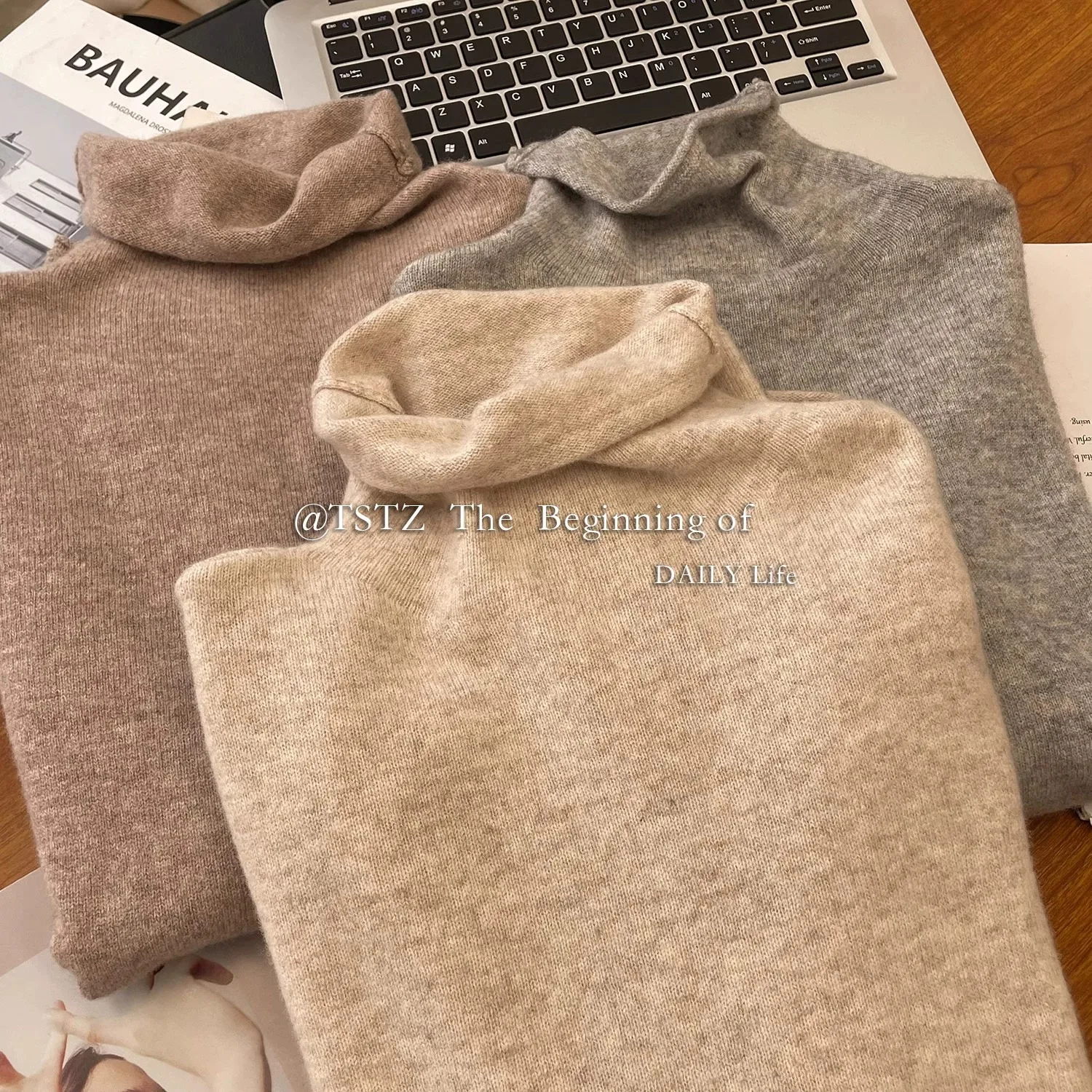
Primary Professional Color Categories:
Core Neutrals: These form the backbone of any professional cashmere collection:
– Navy and charcoal project authority while offering more softness than black
– Camel and taupe provide warmth while maintaining professionalism
– Ivory and winter white create brightness without appearing casual (though require careful handling)
– Black offers timeless formality but can sometimes appear flat against cashmere’s natural texture
Sophisticated Secondary Colors:
– Burgundy and wine tones read as refined and seasonless
– Forest green and deep olive provide subtle distinction
– Plum and aubergine offer personality within professional boundaries
– Sapphire and midnight blue create presence without overwhelming
The psychological impact of color choices in professional settings shouldn’t be underestimated. Navy and charcoal convey reliability and competence, while burgundy and forest green project creativity within structure. Women’s cashmere turtlenecks in these sophisticated hues create instant polish when paired with tailored separates.
Different workplace environments dictate appropriate color intensity. Conservative fields like law, finance, and traditional consulting favor neutral-dominant wardrobes with subtle accent colors. Creative industries and modern tech environments welcome more expressive color stories, though still within professional boundaries.
When building your professional cashmere collection, establish color cohesion by selecting pieces that work together. Begin with three core neutrals, then add 1-2 sophisticated accent colors that complement your overall palette, creating multiple combination possibilities with existing wardrobe pieces.
The Art of Professional Layering with Cashmere
Mastering strategic layering transforms cashmere from simple knitwear to sophisticated office attire. Professional layering balances comfort, function, and formal appearance without creating bulk or overheating.
Strategic Layering Principles:
Apply the Rule of Thirds: Professional outfits appear most balanced when proportioned into thirds. For example, pair a cropped cashmere cardigan with high-waisted trousers, or a hip-length sweater with mid-rise pants and heeled shoes. This creates visual harmony essential in professional settings.
Create Texture Contrast: Pair cashmere with structured fabrics like wool gabardine, cotton poplin, or silk charmeuse. This contrast highlights cashmere’s luxury while maintaining professional structure—matte cashmere against subtly lustrous silk creates sophisticated depth.
Manage Bulk While Maintaining Structure: Select finer gauge cashmere (12-16 gauge) for layering under jackets. Layer thinnest materials closest to the body, progressively increasing weight with outer layers. For example: silk shell, 14-gauge cashmere sweater, structured wool blazer.
Regulate Temperature Thoughtfully: Leverage cashmere’s natural temperature regulation by choosing appropriate weights seasonally. The ultimate guide to layering cashmere cardigans provides detailed techniques for maintaining professional appearance while adapting to changing office temperatures.
Essential base layers that complement cashmere include fine cotton poplin shirts, lightweight silk blouses, and tissue-weight cotton t-shirts with higher necklines. The structural outer layers that provide formality include tailored blazers (slightly sized up to accommodate knitwear), structured vests, and lightweight wool coats.
For day-to-evening transitions, employ the “subtract and add” technique: remove one daytime professional layer (like a blazer) and add one evening-appropriate element (such as a statement necklace or dressy scarf) while keeping the cashmere layer constant.
Styling Cashmere Sweaters for Professional Settings
Different cashmere sweater styles require specific styling approaches to maintain professional appropriateness while maximizing their luxurious appeal.
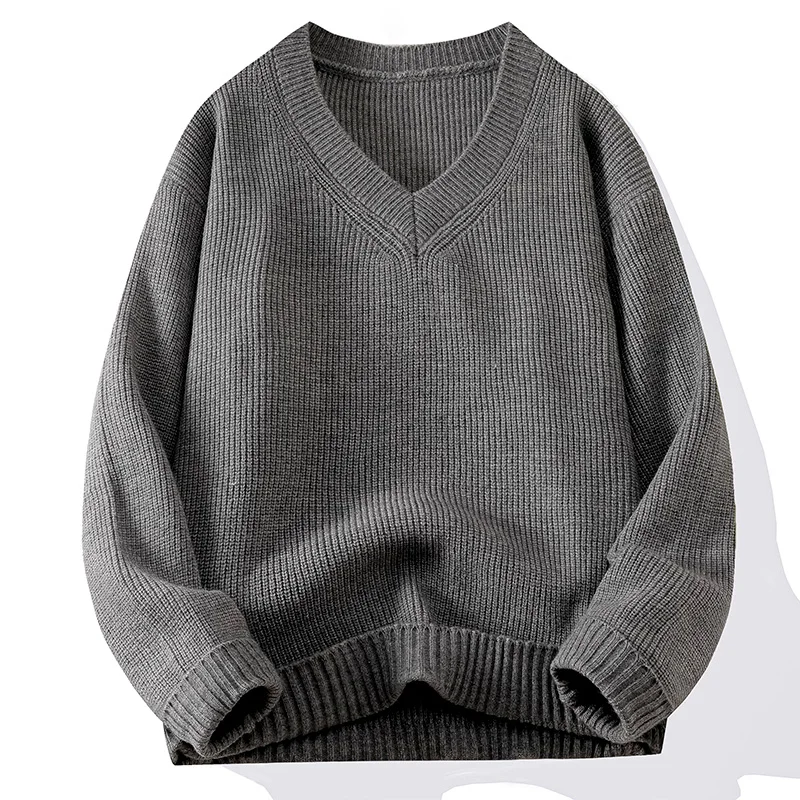
Crewneck Styling for Office Settings:
Collar Management: When layering with collared shirts, ensure the shirt collar rests flat against the neckline rather than bunching. For women, consider the “collar out, small pendant” approach for additional polish.
Bottom Pairings: Balance the relatively casual crewneck profile with distinctly formal bottoms. For men, pressed trousers rather than chinos; for women, tailored pencil skirts or wide-leg trousers rather than A-line styles.
Accessory Integration: Add structure with a pocket square (men) or delicate necklace at collar height (women).
V-neck Styling Techniques:
Neckline Depth: Professional V-necks should create a narrow “V” ending approximately 2-3 inches below the collarbone. Anything deeper reads as casual.
Layering Approaches: For men, undershirts should never be visible; shirts should show approximately ¼-½ inch of collar above sweater neckline. Women can layer with silk shells or button-ups, showing just enough fabric to frame the neckline.
Jewelry Considerations: Men can add subtle watch cuffs; women should select necklaces that follow the V-shape rather than competing with it.
Turtleneck Styling for Maximum Professionalism:
Creating Elongated Silhouettes: Turtlenecks naturally create vertical lines—enhance this with monochromatic pairings and longer outerwear.
Structure Enhancement: Since turtlenecks lack the natural structure of collars, pair with sharply tailored blazers or jackets with defined shoulders.
The versatility of men’s cashmere pullovers for office wear depends on these precise styling choices. Even a simple pullover can appear boardroom-ready when paired with formal trousers, quality leather accessories, and appropriate outerwear.
Cashmere Cardigans: Versatile Office Staples
Cardigans offer perhaps the greatest styling versatility among cashmere garments, functioning as everything from light jackets to layering pieces in professional environments.
Types of Cardigans and Their Professional Applications:
Classic Button-Front Cardigans: These function beautifully as sweater replacements when structured enough to maintain shape throughout the day. The key professional details include non-gapping buttons, reinforced buttonholes, and consistent knitting tension throughout.
Longline Cardigans: These create dramatic vertical lines that elongate the silhouette. For professional environments, select versions with some structure in the shoulder and a clean drape rather than excessive volume. They pair exceptionally well with sheath dresses or matching separates.
Wrap Styles: These offer feminine structure with appropriate coverage when selected carefully. Professional wrap cardigans feature secure closures (interior buttons or ties) that prevent unintended reveals, consistent thickness throughout, and appropriate length (mid-hip to knee).
Strategic buttoning techniques transform how cardigans read in professional environments. For maximum formality, button the middle 2-3 buttons, leaving top and bottom undone. This creates a tailored appearance while maintaining ease of movement. The styling techniques for versatile cashmere cardigan looks demonstrate how simple adjustments can take these pieces from casual to corner office.
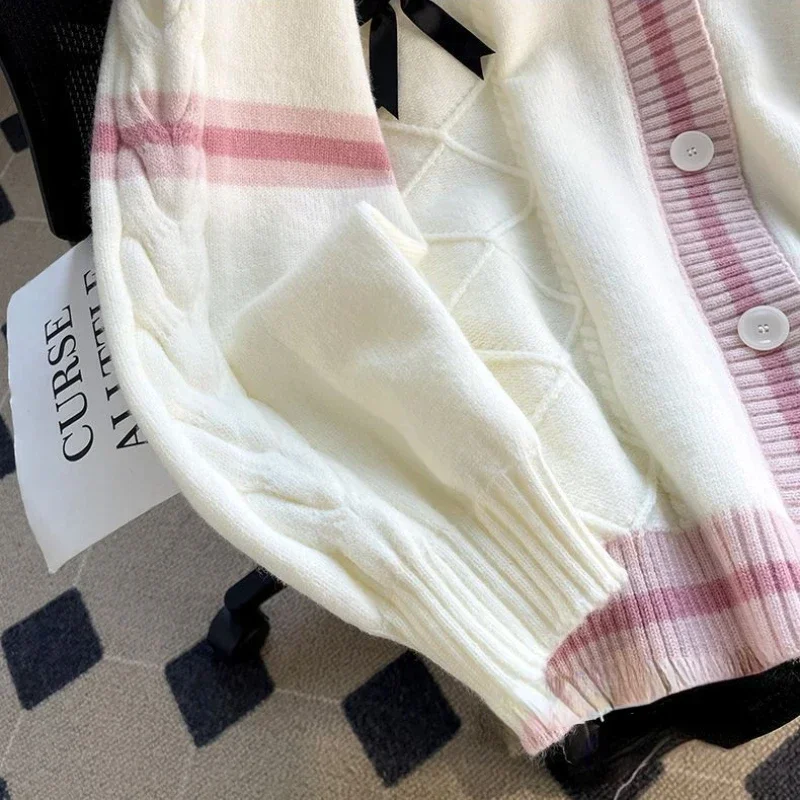
Belt integration provides additional structure with longer cardigan styles. Select thin, structured leather belts in complementary tones and position them at the natural waist over closed cardigans.
Common cardigan styling mistakes in professional settings include allowing buttons to gap (select proper sizing), pairing with overly casual bottoms, and neglecting proper underpinnings. Estate Cloth’s women’s cashmere cardigans feature the refined details necessary for professional environments, including quality closures and consistent knitting tension.
Accessorizing Cashmere for Professional Impact
Thoughtful accessories transform cashmere from merely comfortable to decidedly professional, adding structure, interest, and formality to naturally soft silhouettes.
Jewelry Considerations with Professional Cashmere:
Complementary Metal Tones: Silver and white gold create crisp contrast with darker cashmere colors; yellow gold and rose gold warm up neutrals like camel and ivory. Maintain consistent metal tones throughout your accessories for a cohesive professional appearance.
Appropriate Scale: Professional settings generally call for refined jewelry rather than statement pieces. Select delicate chains, small pearls, or modest earrings that enhance rather than compete with cashmere’s natural elegance.
Strategic Placement: To avoid damaging delicate cashmere fibers, select smooth-backed jewelry without sharp edges. Brooches should only be pinned through reinforced areas like plackets or collars, never directly on the knit.
Professional-Grade Accessories That Enhance Cashmere:
Structured Leather Goods: Slim leather belts (no wider than 1 inch for most professional settings) in complementary tones add definition to cashmere cardigans and dresses.
Quality Timepieces: Select watches with clean lines and appropriate scale—oversized sports watches compete with cashmere’s refinement, while dress watches complement it.
Refined Footwear: Leather shoes with minimal embellishment create grounding structure beneath cashmere’s softness—think classic pumps, loafers, or cap-toe oxfords depending on your industry’s formality level.
Cashmere wrap sweaters themselves can function as statement accessories when draped strategically. For professional settings, fold rather than bunch these pieces, creating clean lines across shoulders or around the neck.
The professional impact of accessorizing comes from restraint and quality rather than quantity. Select fewer, better accessories that serve clear purposes—adding structure, introducing complementary color, or providing functional elegance to cashmere ensembles.
Adapting Cashmere for Different Office Environments
Professional cashmere styling must respond to your specific workplace culture and expectations. What reads as appropriately professional varies significantly across different office environments.
Formal Corporate Settings:
In traditional corporate environments like law, finance, and consulting firms, cashmere works best as a subtle luxury element within conventional business attire:
Integration with Suiting: Layer fine-gauge cashmere sweaters under suit jackets, ensuring sleeves end precisely at wristbone and necklines don’t compete with lapels.
Color Discipline: Maintain a predominantly neutral palette (navy, charcoal, camel) with minimal pattern introduction.
Strategic Reveals: Allow cashmere to appear as thoughtful accents—at collar and cuff lines, or as visible layers beneath structured outwear.
Business Casual Offices:
For moderately formal environments like corporate offices with relaxed dress codes:
Balance Structure with Comfort: Pair cashmere sweaters with one structured element (tailored pants or skirt) and one more relaxed element (loafers instead of formal shoes).
Material Mixing Strategy: Combine cashmere with other high-quality materials in different textures—wool trousers, silk blouses, fine cotton shirts—to create sophisticated depth without excessive formality.
Professional elegance in office cashmere comes from understanding these environmental nuances and adjusting styling accordingly.
Creative or Smart-Casual Workplaces:
In design firms, tech companies, and media environments:
Trend Integration: Incorporate one trend element (current silhouette, seasonal color) while keeping other elements classic.
Statement Cashmere: Use more distinctive cashmere pieces (interesting knit patterns, brighter colors) as focal points, keeping other elements understated.
For video presentations and remote work, prioritize solid-colored cashmere in mid-to-dark tones that frame the face without creating distractions. Avoid very light colors that can wash out on camera and highly textured knits that may create visual noise.
Selecting the right cashmere pieces for your professional wardrobe depends largely on accurately assessing your workplace culture and adapting accordingly.
Seasonal Transitions: Year-Round Cashmere for the Office
Cashmere’s remarkable temperature regulation makes it viable for professional wear across seasons, with strategic adjustments for changing conditions.
Lightweight Cashmere for Warm Weather Offices:
Gauge Selection: For summer offices, select 12-14 gauge (fine) cashmere in 2-ply construction, which provides structure without excessive warmth.
Summer Styling Techniques: Layer lightweight cashmere over, rather than under—think draped cardigans over sleeveless shells or light tees, providing appropriate coverage while accommodating air conditioning.
Warm Weather Colors: Lighter neutrals like ivory, silver-gray, and pale camel appear seasonally appropriate while maintaining professionalism.
Transitional Season Strategies:
Layering Adjustments: Implement the “subtract by afternoon” approach—begin with a three-part layer (shell, cashmere, jacket) that can be reduced to two parts as the day warms.
Convertible Styling Options: Select pieces that function in multiple configurations—wrap cardigans that work closed or open, sweaters that can be half-tucked or fully untucked as needed.
Lightweight cashmere options provide excellent versatility during these transition seasons when office temperatures are most unpredictable.
Cold Weather Office Styling:
Strategic Layering Without Bulk: Layer thinner cashmere pieces rather than relying on a single heavy garment—a cashmere shell under a cashmere cardigan creates warmth without compromising professional lines.
Structure Maintenance: In heavier winter knits, reinforce structure with tailored outerwear and accessories—leather belts, structured bags, and polished boots provide necessary definition.
The key to year-round cashmere professional styling is selecting appropriate weights and employing strategic layering rather than retiring these versatile pieces seasonally.
Cashmere Wrap Sweaters, Women's Cashmere Pullovers
$75.89 Select options This product has multiple variants. The options may be chosen on the product pageCashmere Wool Cardigans, Women's Cashmere Cardigans
Price range: $92.23 through $92.45 Select options This product has multiple variants. The options may be chosen on the product pageCropped Cashmere Cardigans, Women's Cashmere Cardigans
$86.75 Select options This product has multiple variants. The options may be chosen on the product pageMen's Cashmere Pullovers, Men's V-Neck Cashmere Sweaters
Price range: $90.79 through $96.98 Select options This product has multiple variants. The options may be chosen on the product pageMen's Cashmere Pullovers, Short Sleeve Cashmere Sweaters
$93.56 Select options This product has multiple variants. The options may be chosen on the product pageBrushed Cashmere Sweaters, Men's Cashmere Pullovers
Price range: $110.84 through $118.66 Select options This product has multiple variants. The options may be chosen on the product page
Professional Cashmere Care: Maintaining a Polished Appearance
Proper maintenance ensures your professional cashmere pieces continue projecting polish and competence wear after wear.
Office-Specific Care Considerations:
Managing Professional Hazards: For coffee spills, blot immediately with a clean napkin and sparkling water if available. Carry a stain pen suitable for protein fibers for ink marks or food spots.
Quick Workplace Fixes: Keep a small lint roller in your desk drawer for midday refreshes. A clean makeup brush can dust away desktop debris from cashmere surfaces without damaging fibers.
Commuting Protection: During transit, protect cashmere under water-resistant outerwear. For rainy days, select cashmere in darker colors that show moisture less prominently if accidentally exposed.
Essential Maintenance Routine:
Professional-Grade Cleaning: Hand wash using lukewarm water and specialty cashmere shampoo, or dry clean only at trusted establishments that specify experience with luxury knitwear.
Storage Protocols: Fold rather than hang to maintain structure; store with breathable fabric covers and cedar elements to deter moths. Best practices for cleaning cashmere sweaters should be followed meticulously to maintain professional appearance.
Between-Wear Refreshing: Allow 24 hours of rest between wearings; refresh with a gentle fabric brush in one direction only; remove pills using only a specialized cashmere comb.
Extending Professional Lifespan:
Rotation Strategy: Maintain at least 3-5 core professional cashmere pieces to avoid over-wearing any single item. This prevents premature wear patterns, especially in high-friction areas.
Reinforcement Techniques: At first sign of thinning at elbows or cuffs, seek professional reinforcement rather than waiting for visible wear. Some specialty dry cleaners offer preventative reinforcement of vulnerable areas.
Professional appearance standards demand cashmere that looks pristine—implementing these care routines ensures your investment pieces continue meeting these standards throughout their lifespan.
Supplemental Content: Cashmere Sustainability in Professional Wardrobes
The sustainability of professional cashmere extends beyond environmental considerations to include durability, versatility, and ethical sourcing—all factors that impact both professional image and personal values.
Quality-Sustainability Connection:
Longevity Impact: Premium cashmere pieces typically maintain their professional appearance for 10+ years with proper care, compared to 1-3 years for lower-quality alternatives. This reduced replacement frequency significantly lowers environmental impact.
Versatility Factor: High-quality cashmere pieces often serve multiple professional functions—a well-constructed cardigan works as a light jacket, layering piece, or standalone sweater, reducing the need for multiple garments.
Ethical Considerations for Professional Cashmere:
Source Certification: Look for pieces from companies that participate in sustainable harvesting programs like the Sustainable Fibre Alliance or Good Cashmere Standard.
Supply Chain Transparency: Brands that openly share sourcing and production information typically maintain higher ethical standards throughout their processes.
Building a Sustainable Professional Wardrobe:
Quality-First Approach: Five premium cashmere pieces will serve your professional needs better than fifteen lower-quality items that quickly lose their polish.
Calculation Strategy: When evaluating professional cashmere, calculate cost-per-wear over a five-year period rather than focusing solely on purchase price. A $350 sweater worn 50 times annually for five years costs just $1.40 per wear.
The most sustainable professional wardrobe consists of fewer, better pieces selected for maximum versatility and maintained with proper care—principles perfectly aligned with cashmere’s inherent qualities.
Is Cashmere Worth the Investment for Professional Wear?
When evaluating cashmere as a professional wardrobe investment, consider both tangible and intangible returns on that investment.
From a purely financial perspective, premium cashmere offers exceptional value when assessed through cost-per-wear analysis. A $300 cashmere sweater worn twice weekly during cooler months (approximately 40 wears annually) for five years results in a $1.50 cost per wear—comparable to or better than mid-range synthetic alternatives that require replacement after 1-2 seasons.
Beyond simple mathematics, professional cashmere delivers significant qualitative benefits. The psychological comfort provided by well-fitting, temperature-regulating garments translates to increased confidence and presence during critical professional moments. The subtle message of quality and attention to detail communicated by premium materials often aligns with professional values of excellence and thoroughness.
The investment value varies by career stage and industry. Early-career professionals might begin with 1-2 foundational pieces in versatile neutral colors, while established executives might justify a broader collection including more specialized pieces. Industries where personal presentation directly impacts client perception (law, finance, consulting) typically see greater return on premium wardrobe investments than fields where technical skills predominate.
The versatility of quality cashmere also enhances its value proposition—cashmere cardigans can justify their investment through their ability to function across multiple professional contexts, from office to client meetings to business travel.
Can Cashmere Be Too Casual for Formal Business Settings?
The formality level of cashmere depends entirely on specific garment characteristics rather than the material itself. With careful selection, cashmere can meet even the most stringent professional standards.
Factors Determining Cashmere’s Formality Level:
Weave Structure: Tighter, finer-gauge knits with minimal texture present as more formal than loose, highly textured versions. For the most formal settings, select 12-14 gauge cashmere with minimal visible knit pattern.
Construction Details: Look for reinforced shoulders, clean seams, defined edges, and quality closures. These structural elements signal intentional formality rather than casual comfort.
Context and Combination: Even the finest cashmere sweater becomes appropriately formal when paired with a crisp shirt, tailored trousers, and polished accessories. Conversely, even structured cashmere reads as casual when paired with denim or sporty elements.
In the most formal business settings (international finance, traditional law firms, diplomatic settings), cashmere works best as a secondary layer—visible at collar and cuffs beneath suiting, or as a refined layer under structured blazers.
To elevate cashmere for highly formal contexts, employ these techniques:
– Layer under clearly formal pieces like suit jackets or tailored blazers
– Select dark, solid colors (navy, charcoal, black)
– Ensure impeccable fit with no stretching or sagging
– Pair with crisp collared shirts and traditional business accessories
When Should You Choose Other Materials Over Cashmere for Office Wear?
While cashmere offers exceptional benefits for professional settings, certain situations may call for alternative materials:
Situational Considerations:
High-Activity Roles: Positions requiring extensive movement or physical activity may benefit from more durable wool-synthetic blends that resist abrasion and maintain structure through repeated movement.
Extremely Formal Presentations: For high-stakes formal presentations, structured woven materials like wool suiting or silk may project more traditional authority than even the finest knitwear.
Budget Strategy: When building a professional wardrobe within constraints, prioritize one or two quality cashmere pieces for high-visibility situations rather than multiple lower-quality items across categories.
Complementary Materials:
Fine Merino Wool: Offers more natural structure and resilience than cashmere, with less luxury but greater durability for daily wear. Ideal for foundational pieces worn weekly.
Cotton-Cashmere Blends: Provide the comfort of cashmere with improved durability and typically lower price points. These 85-90% cotton/10-15% cashmere blends work well for season-transition pieces.
Silk-Cashmere Combinations: Create exceptional drape with reduced weight, perfect for layering pieces in warmer months or humid climates where pure cashmere might feel too insulating.
These alternatives don’t diminish cashmere’s value but rather complement it within a thoughtfully curated professional wardrobe. The most effective approach often involves selecting the right material for each specific garment’s function rather than applying a single material preference across all categories.

